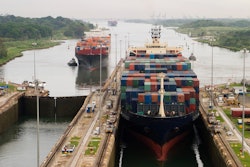
Just over a year ago, the Ever Given container ship was stuck in the Suez Canal. The 400-meter vessel blocked one of the world’s key trading arteries for over a week, disrupting $60 billion worth of trade and causing ships to queue patiently for days, or risk a small detour around the Cape of Good Hope.
The crisis and its corresponding news coverage placed the global supply chain front and center in the public consciousness. It served as a stark reminder of the fragility of logistics and brought to light the vulnerabilities of a system most people take for granted.
Though perhaps the most mainstream, the Ever Given blockage was just one of many severe supply chain disruptions of recent days. Brexit and its accompanying regulations have proved a headache for moving goods in and out of Britain, at least in the short-term, and pandemic-related port closures in China, in particular Yantian and Ningbo, have had a devastating impact on freight rates.
We are staring down the barrel of yet another stormy year, with increasing food shortages and empty shelves an increasingly regular sight. And that’s all before feeling the full effect of the Russia/Ukraine war, a country often dubbed the “breadbasket of Europe” that accounts for 4% of global corn and wheat supplies, 7% of barley and 31% of sunflower oil, according to the U.S. Department of Agriculture.
Against this backdrop, a seachange is required. Until now, supply chain management has relied on antiquated technology and been fundamentally reactive rather than proactive. While larger organizations may be able to weather these supply chain storms, for smaller businesses, it can be make or break. Before the next crisis inevitably hits, many organizations would do well to adopt digital solutions to better manage their supply chain risks.
The best way to make any process resilient is to build it on solid foundations. Supply chains are no different, and so time spent on the procurement stage (the finding, comparing and vetting of suppliers) will mean time saved later down the line. Procurement can be an opaque business, with outdated software solutions like email (or in extreme cases, even pen and paper) leading to all sorts of problems. But change is afoot, with more and more digital platforms emerging that can give professionals full visibility on their suppliers. This is a step in the right direction of transparency and auditability and building a robust supply chain from start to finish.
Historically, procurement was more of a reactive process, with experts primed to establish last-minute contingency plans but with little visibility to be proactive. This cannot continue, as such outdated methods have repeatedly left companies ill-prepared to deal with large and unforeseen supply chain disruptions due to procurement processes that do not take into account the importance of finding, evaluating and choosing suppliers.
Being able to choose from a vast range of suppliers means that when disaster hits, businesses have access to a framework where buyers are genuinely go-to-market for all of their commercial contracts. This allows you to be more agile in dealing with new partners and reduces the concentration of risk that comes with a narrow pool of suppliers. While a business may initially overlook the value in going out to more suppliers than might seem necessary, its importance cannot be overstated. When the Ever Given was stuck in the Suez Canal, it reminded the industry of the importance of diversifying one’s supply chain portfolio.
Besides facilitating flexibility and diversification of suppliers, another perk of having a digitally transparent procurement process is that it allows for much clearer oversight and enhances the usefulness of supply chain mapping. There are several advantages that go far beyond merely providing visibility. With enhanced mapping capabilities, businesses can learn more about how their products or services are created, where they are produced and by whom. This mapping can serve as one of the cornerstones for a supply chain's risk management.
Recent events have certainly made the industry reflect on the resilience on the food supply chain. As with any crisis, there are important lessons to learn and the challenges of today call for a much-needed change in approach. More focus needs to be put into the earlier stages of the supply chain, such as procurement. And technology - and the visibility it affords - must be focused on and invested in. There will be no quick fixes and there are definitely more bumpy waters ahead, but that doesn’t mean businesses can’t be prepared. In fact, those who do will flourish.



















